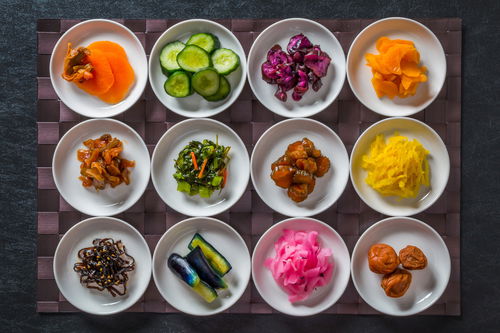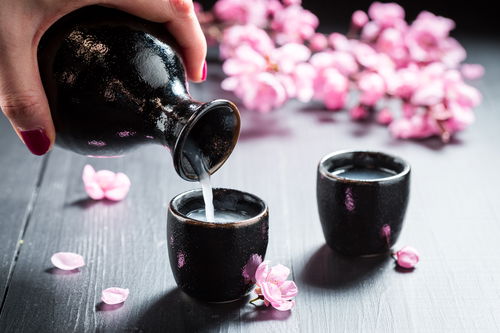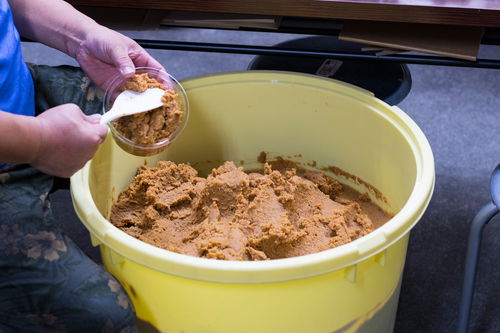Table of contents:
From spice pastes to beverages, from breakfast to dinner: Fermented foods play a very important role in Japanese cuisine. And for good reason, because fermentation essentially brings out the best in food and makes it incredibly healthy. The fermentation process creates microorganisms that make food easier to digest. The positive effects of fermented foods on the gut flora are scientifically proven. There are proportionally many foods in Japan that are consumed in their fermented state. Particularly well known are the soybean paste Miso as well as fermented soybeans Natto, which are often eaten for breakfast.
Why are there so many fermented foods in Japan?
The Japanese climate is perfect for the fermentation process of food. Japan is usually quite hot and humid. In almost every region of the country, food can therefore be fermented relatively easily and without expensive accessories.
That's why there are more fermented dishes in traditional Japanese cuisine than in most other countries. Forerunners of today's Japanese spice classic Miso have been known since the 8th century. Originally, the fermentation of fresh food was necessary to make fruit and vegetables last longer. Over time, the fermentation processes have continuously evolved, and today no Japanese chef can do without fermented ingredients!
How are fermented foods eaten in Japan?
It depends on the food. Some fermented specialties, such as the soybeans Natto, are a popular breakfast. Pickled vegetables are often served as a side dish or salad. The fermented plum Umeboshi is said to have various positive health effects - that's why it is used in different dishes, from sauces to fillings for rice balls. Other fermented specialties such as Miso and soy sauce are primarily used as seasonings.
What happens during fermentation?
When a food ferments, the enzymes of the microbes break down the starch and protein of the food and transform them into amino acids and sugars. Fermented foods usually have a very intense flavor.
What types of Japanese fermentation methods are there?
Fermentation with Koji fungus - Shio Koji
Koji is the starting point for the fermentation process of many Japanese foods. It is a mold fungus. Miso, soy sauce, sake, rice vinegar and mirin are all made on the basis of Koji. But vegetables can also be transformed into real delicacies with Koji: radishes, radishes and cucumbers, for example.
Vinegar - Suzuke
When you think of pickled vegetables, you probably think of vinegar as a pickling liquid. This is also common in Japan. Celery, peppers and carrots taste particularly delicious pickled. You can also easily pickle your own vegetables at home. Dare to experiment!
Salt - Shiozuke
This is the oldest form of fermentation. Among other things, Wakame seaweed and Umeboshi (Japanese plums) are fermented with salt.
Rice bran - Nukazuke
Rice bran is made from brown rice and mixed with salt and water for fermentation. The foods - usually vegetables - that are pickled in rice bran are often eaten for breakfast. They taste slightly salty, soft but crunchy, and slightly earthy.
Sake - Kasuzuke
This special form of fermentation is usually carried out in regions where there is a sake brewery. The food is fermented in a mixture of sake, mirin, salt and sometimes sugar. Popular vegetables are carrots and ginger. In addition to vegetables, fish is also pickled in sake - especially salmon and cod. Kasuzuke food tastes balanced but intense.
Soy sauce - Shoyuzuke
A completely different but particularly delicious approach are vegetables that are pickled in soy sauce. The vegetables you pickle in soy sauce taste salty, sour and umami. Darker vegetables are particularly suitable - because the soy sauce dyes everything pickled dark!
Mustard - Karashizuke
Sake is also used in this fermentation technique. In addition, the pickling liquid is supplemented with salt, sugar, mirin and mustard. A well-known specialty of Karashizuke is Nasu Karashizuke - pickled eggplants.
What fermented foods are there?
From vegetables to alcohol to fish innards: Fermented foods are everywhere in Japan. Some of them are very old, others are used so often that it's easy to forget that fermentation is happening there too. We can't list all the fermented foods that exist, but at least the ones you're most likely to encounter.
Miso
This paste is one of the most commonly used spices in Japanese cuisine. It is made from fermented soybeans and is available in various intensity levels. You know Miso, for example, from the delicious miso soup. You can buy Miso very easily on Amazon.

Natto
Natto is made from fermented soybeans. Natto bacteria are added to cooked soybeans and kept warm and moist for 24 hours. The result is a slightly slimy, strongly smelling dish that pulls threads when you eat it. Natto is often eaten for breakfast, served with rice or used as an ingredient in other dishes.

Tsukemono
"Tsuke" translates as "pickled" and "mono" means "thing". Tsukemono can therefore refer to a variety of pickled foods. Most of the time it's vegetables. Cucumbers, winter radish (Daikon), carrots and eggplants are very popular pickled. The pickling methods vary as much as the vegetables: There is, for example, Tsukemono in vinegar, sake, rice bran and salt. Tsukemono are often eaten as a side dish or as a snack with alcoholic drinks. Here we have a big article for you where you can find everything about Japanese pickled vegetables:

Takuan
This pickled Japanese winter radish is strictly speaking one of the Tsukemono, but it is extremely popular. It is easy to recognize by its bright yellow color, and you will encounter it in many Japanese dishes. It is particularly popular as an accompaniment to sushi. Takuan is fermented for about six months. You can get Takuan on Amazon. We also have an article about Takuan for you here.

Umeboshi
This is one of the most popular fermented foods in Japan. This dried and then fermented plum looks a bit wrinkled, but offers a concentrated taste experience! It tastes salty and sour to very sour, depending on how much sugar was used in the fermentation. Because Umeboshi are fermented, they also provide a concentrated dose of vitamins and nutrients. In Japan, the pickled plum is considered a true miracle cure! It is said that Umeboshi were even eaten by the samurai before they went into battle - to give them an extra dose of energy. They are treated with one of the oldest fermentation techniques, lactic acid fermentation: First, the plums are pickled in salt, then dried and finally pickled in vinegar again. Umeboshi gets its red color from the addition of leaves from the Shiso plant.

Sake
Japanese rice wine is also produced by fermentation. Sake is based on rice, water and the fungus Koji. Incidentally, there are various types of sake. We have written an article summarizing the special features of the Japanese drink.

Shoyu
No Japanese dish is complete without being seasoned with soy sauce! Soy sauce - Shoyu in Japanese - is a must-have in every household in Japan. It is one of the oldest sauces in the world! Shoyu is made by mixing steamed soybeans with wheat, mold fungus, water and salt. Over time, the proteins in the soybean are broken down by enzymes, creating the liquid soy sauce. This is filtered and pasteurized. Incidentally, the production of Shouyu takes a good 6 months! Soy sauce is used as a dip and as a seasoning and brings out the natural flavor of the other ingredients. Here we have an article where you can learn all about the differences between the different soy sauces.
Shiokara
This Japanese specialty should only be eaten by those who really like fish! Shiokara consists of the salted, fermented innards of various marine animals. Accordingly, the taste of Shiokara is very intense - it is best to eat the specialty with pure whiskey.
Imojochu
This alcohol is made from sweet potatoes and is known for its sweet taste. It is made from a base of Koji-infused rice, water, yeast and sweet potatoes. It can then be distilled again, resulting in a more intense, clearer flavor.





Comments